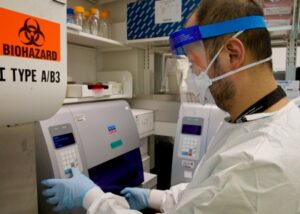DoD Reports Just More Than 100 Cases as of Mid-September
WASHINGTON, DC — When the World Health Organization declared monkeypox a public health emergency on July 23, there were more than 4,000 reported cases in the United States. By mid-September, the number of reported U.S. cases had surpassed 24,000.
While monkeypox is less contagious and less lethal than COVID, those who contract monkeypox say the pain can be excruciating. The symptoms—including headache, fatigue, fever, chills, muscle aches and swollen lymph nodes—can last as long as two to four weeks. For immunocompromised people, monkeypox virus infection may present with atypical manifestations or more severe illness (for example, sepsis, disseminated rash), according to the national Centers for Disease Control and Prevention.
Both the VA and DoD are taking important steps to protect their members and help curb the spread through vaccination, education and other measures.

Victor Sugiharto, a technical and general scientist with Naval Medical Research Center’s (NMRC) Naval Infectious Diseases Diagnostic Laboratory (NIDDL), analyzes samples for the presence of the Monkeypox virus. The NIDDL in Silver Spring, MD, is the Navy’s clinical reference laboratory and has the capability to test for non-routine infectious diseases affecting servicemembers. U.S. Navy photo by Sidney Hinds
“VA has convened a group of subject-matter experts and key stakeholders to ensure a swift and comprehensive response to this new emerging infection,” said VA spokesperson Gary J. Kunich in an emailed statement to U.S. Medicine. It is working in close collaboration with local and state public health authorities and with other federal agencies to ensure access to testing, treatment and prevention tools, such as antivirals and vaccines, he said.
At press time, the VA had received an initial 13,000 vials (65,000 doses) of Jynneos monkeypox vaccine from the Department of Health and Human Services and had distributed vials to all 18 VISNs, Kunich said. The VA will continue to receive additional allocations of vials of the vaccine reduce the spread of monkeypox as more product is available within the supply chain.
Once distribution and vaccine administration training at VAMCs has been completed, VA will begin offering the Jynneos vaccine to veterans at highest risk of infection, he said.
CDC Gives Guidelines to Assess Risk
The CDC provides tiered risk assessments for exposure. High-risk category includes individuals who have been contacted by their local public health departments, have had close or intimate contact in the past 14 days with an individual with monkeypox or have had multiple sexual partners in the past 14 days in an area with known monkeypox.
Individuals at high risk also include people who may live in the same household with an infected person, share the same space or touch the same objects and having close, intimate contact.
Moderate-risk situations include exposure to respiratory droplets or attending an indoor event with an infected person where prolonged, close contact could occur.
Vaccine Effectiveness and Administration
Jynneos, the Modified Vaccinia Ankara (MVA) vaccine, was approved in 2019 for prevention of smallpox and monkeypox disease in adults 18 years of age and older determined to be at high risk for smallpox or monkeypox infection. JYNNEOS is administered subcutaneously as two doses, 28 days apart. For individuals 18 years of age and older determined to be at high risk of monkeypox infection, the emergency use authorization (EUA) allows for a fraction of the JYNNEOS dose to be administered intradermally, greatly increasing the number of people who can be vaccinated with a limited supply of vaccine.
To ensure the availability of vaccine to those who need it, most veterans will receive the lower dose, said Kunich. Most veterans will receive a small dose into the forearm, though some veterans who have had a keloid will get a larger dose in the upper arm.
When administered before an exposure, the vaccine has been shown to be highly effective against monkeypox; there is evidence that vaccination after exposure may also prevent monkeypox or lessen its severity.
Information for Patients and Providers
Along with the vaccine, education for veterans, military personnel and clinicians who treat them is key to reducing the spread and impact of monkeypox.
CDC urges healthcare providers in the U.S. to be alert for patients who have rash illnesses consistent with monkeypox. Information for clinicians regarding recognition, vaccination, isolation recommendations and treatment are available on the CDC website.
Meanwhile, the DoD is responding to what, so far, is a relatively small outbreak in the military. “The Department of Defense continues to monitor human-to-human transmission of monkeypox,” Peter Graves, chief of media operations for the Defense Health Agency, stated in a written statement to US Medicine. As of Sept. 9, there had been 107 confirmed and probable monkeypox cases in the military health system, he said. “While it has not become a widespread threat to our forces, we are committed to ensuring the health and safety of our troops both home and abroad and will ensure they have all the information they need to protect themselves at their disposal.”
Military installations and sites such as Health.mil include information and tips on protecting oneself against the possibility of infection, said Graves. “All information provided is in line with CDC guidance.”


